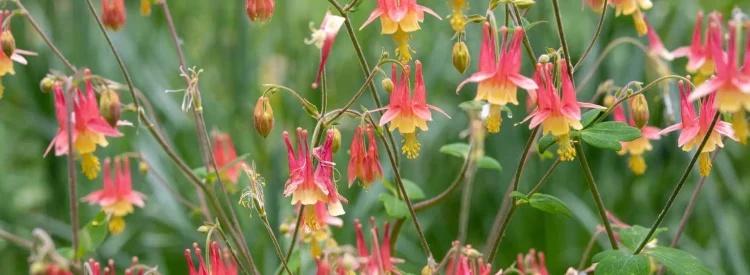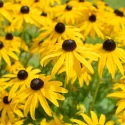You’ve got to hand it to evolution: it’s made some beautiful plant-animal pairings. Take native columbines, for example. Their exquisite flowers hang downwards from delicate stems. Look closely, and you’ll notice these bell flowers look like elongated gnome hats with the top tapering off. What does that shape perfectly align with? Hummingbird beaks!
Native columbines have adapted to be perfect hummingbird feeders. Ruby-throated hummingbirds are the main pollinator for many native columbines. Scroll on to meet a few favorites.

There are almost 100 flowers globally that are technically “columbines” and belong to the plant genus Aquilegia. These flowers come from regions across the globe, mainly in Europe and North America. We’re here to pay homage to the North American native columbines. In this article, we’ll introduce the benefits of planting native columbines, introduce a few species native to North America, and share an overview on why you’ll find lots of columbine color options.
Let’s start with why we should plant native columbine.
What are the benefits of planting native columbine?
Planting plants that are native to your home area is important and returns lots of benefits. Some benefits of planting native plants, like native columbines include:
- Wildlife support: Native plants are the preferred food for the wildlife we love: many columbines feed hummingbirds
- Resilience in your region: Native plants know their region’s soil, weather, and climate better than any other plants on Earth. They have evolved to be experts at growing in their home area.
- Time and money savings: Once native plants are established, most thrive with just rain
- Beauty: Native plants are gorgeous. Explore our native plant library, or scroll on to meet some beautiful options for your yard
New to native?
Before lawns and landscaping, native plants were here. They’ve fed birds, bees, and butterflies for thousands of years—and they’ll do the same in your yard. The best part? They’re easier to grow than you think.
Now that we’ve covered why planting native columbines is important and beneficial, let’s meet a few native columbine species for North American gardens.

Meet some North American native columbines
There are dozens of columbines native to North America. Here are a few options that are usually found at native plant nurseries.
Native Columbines for Eastern North America

Red Columbine
Aquilegia canadensis
This is the native columbine to find if you’re on the East Coast. Red Columbine‘s native range stretches from Nova Scotia all the way south to Florida and Texas. Its flowers open when the ruby-throated hummingbirds are migrating. (No need to check hummingbird migration maps when you plant this flower! Just look out the window.)
Native Columbines for Western North America

Blue Columbine
Aquilegia caerulea
Yards in Arizona, Colorado, New Mexico, and Montana have a beautiful choice with Blue Columbine. It’s also the state flower of Colorado. Blue Columbine can get tall—3′ on average—and has some of the largest flowers within native columbines. You will often find cultivars (which stands for CULTIvated VARities) that offer different heights and flower colors. When possible—plant the true native Blue Columbine species.

Golden Columbine
Aquilegia chrysantha
Southwestern states have a beautiful columbine option for gardens: Golden Columbine. Golden Columbines prefer areas near water (they like consistent moisture). When in bloom, they can look like daffodils. Golden Columbines get tall—1-3 feet. So easy to plant by seed if you can find a local plant seller.

Western Columbine
Aquilegia formosa
I know—it looks almost exactly like the similarly named Red Columbine (it also sometimes goes by the common name Crimson Columbine.) But this one is for western gardens! Crimson Columbine is native from Southern California all the way north to Southern Alaska. Yes—what a range! Crimson Columbine can be a dainty plant (6″ high) or at its happiest grow to 3′.
Hmm…I’ve seen other colors before…
You probably have. Columbines easily cross-pollinate to make different blooms, sizes, and behaviors. Let’s go a little deeper into columbines’ family tree and talk about cultivars and hybridization.
If you’re about to scroll by—I promise this is interesting and worth reading.
Many columbine options are cultivars and hybrids
To keep it simple, there are two ways that native columbines can change their looks from their native forms: cultivation and cross-pollination.
Columbine cultivars: curated for a reason
Cultivars are plants that humans have selected. The name cultivar comes from CULTIvated VARiety. Cultivars are made via lots of different sources: some using DNA sequencing, others using old-fashioned “I-like-this-plant-I-will-take-a-seed-or-cutting-and-plant-again” curation. (Read our cultivar overview to learn more.)
You know a plant is a cultivar when its Latin botanical name is followed by a cheeky English name, in single quotes. (The Latin name tells you the original plant parent.) You may encounter the following columbine cultivars:

Aquilegia caerulea ‘Kirigami’: deep shades of blue, maroon, and yellow. Its original parent plant is the Blue Columbine, which we met earlier.
Aquilegia vulgaris ‘Winky Double Dark Blue and White’: stacks layers of dark blue flowers. Its parent plant is the European Columbine, a columbine native to Europe.
Humans created those crazy plants. Now, let’s talk about how nature mixes things up.
Nature changes how columbines can look through hybridization.
Multiple columbines in an area = new colors, shapes, etc in future years
A very cool thing about columbines is that today’s 100+ species come from the same few ancestor plants. Even though one might be yellow and another red, their DNA is very similar. So when a bee moves from one columbine species to another, the resulting seeds will likely be a mix of both species. Plants that are a mix of species mixed up via nature are called hybrids.
When you plant multiple species of columbine together, get ready for lots of fun, interesting hybrids in the coming years. Planting Blue Columbine near a Western Columbine might make a purple-y, medium-sized columbine next year.
If you keep growing this new hybrid or give away seeds to friends, it’s technically a cultivar. Don’t forget to give it a good name!
If you want to keep your columbines looking the same: pick one species
On the other hand, you may be dedicated to planting true native species, or sticking to a similar color palette. If you want to keep your columbines looking consistent, ensure you stick to one species in your yard.
What is a cultivar?
Cultivar is short for CULTIvated VARieties. Cultivars are plants selected for traits like color, size, or disease resistance. Useful and sometimes stunning...but some lose the scent, shape, or timing wildlife depends on. Plant straight species when possible.
What are good places to plant columbines?
Our advice is to plant them in clear sight of your windows. This way, you can sip coffee from the luxury of your home while you watch hummingbirds zip around your garden. (We planted ours outside our kitchen window so we can spot hummingbirds while doing dishes.)
Plant 5+ columbines together to help hummingbirds find food quickly
Planting 5+ is a good rule of gardening if you’re looking to support wildlife. Planting at least five plants together helps wildlife find their favorite native plants. (This is a useful rule for columbines, as well as milkweed—Monarch butterflies host plant.)
Looking to attract hummingbirds?
Visit our article dedicated to hummingbird gardening. Here are also some individual plant profiles that hummingbirds love:
And that concludes our love letter to native columbines! There are almost 100 columbines found worldwide, including dozens of beautiful options native to North America. Planting native plants like native columbines ensures that the hummingbirds and other iconic creatures get what they need to survive, and our gardens are beautiful with minimal work. Plant native columbines in groups of 5+ to ensure hummingbirds can find one of their favorite treats. If possible, plant where you can see the flowers from inside your house so you and the hummers can have breakfast together.
Looking to help hummers? Visit our guide to Planting a Hummingbird Garden or meet the hummingbird-favorite easy-care vine Coral Honeysuckle. Happy planting!
Sources
- Taylor, R.J. Interspecific hybridization and its evolutionary significance in the genus Aquilegia. Brittonia 19, 374–390 (1967). https://doi.org/10.2307/2805535
- Fior, S., Li, M., Oxelman, B., Viola, R., Hodges, S. A., Ometto, L., & Varotto, C. (2013). Spatiotemporal reconstruction of the Aquilegia rapid radiation through next-generation sequencing of rapidly evolving cpDNA regions. New Phytologist, 198(2), 579-592. https://doi.org/10.1111/nph.12163
- Walters, Martin. The Illustrated Encyclopedia of Wildflowers and Flora of the Americas. (2007), 53, 56, 58.
- Britannica, T. Editors of Encyclopaedia. “columbine.” Encyclopedia Britannica, July 18, 2022. https://www.britannica.com/plant/columbine-plant.
- Missouri Botanical Garden, Rocky Mountain Columbine
- Ladybird Johnson Wildflower Center, Eastern Red Columbine
- Ladybird Johnson Wildflower Center, Yellow Columbine
- US Forest Service, Aquilegia Express: The Birds and Bees …hawk moths too!
What if your feed was actually good for your mental health?
Give your algorithm a breath of fresh air and follow us.






















